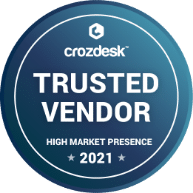Table of Contents
ToggleDeveloped by American Express, Discover, JCB, Mastercard, UnionPay, and Visa, EMV is a global standard for credit cards which use chips to process transactions.
If you’re running a hospitality business, guests will present EMV cards on a daily basis. And that probably means you’ve got lots of questions.
So, let’s get them answered, shall we?
How will EMV affect my business?
Banks are now issuing most of their credit and debit cards with EMV chips. It’s a move that’s designed to reduce credit card fraud and make payments as efficient as possible.
That means, as a business which accepts card payments, you may need new processing devices to read the information on EMV cards.
Since October 2015, businesses without EMV-enabled processing devices have been at risk of fraudulent chip card transactions, leading to something called the ‘liability shift’, which we’ll get to later.
The good news is that the move to EMV is pretty straightforward and cost-effective for most businesses.
But, why are we shifting to EMV?
It’s thought that nearly half of the world’s credit card fraud takes place in the United States.
Take that in for a moment. It’s a serious problem, and one which EMV is designed to reduce considerably.
The reason there’s so much credit card fraud in the United States is because magnetic-stripe cards are still widely in use. Unfortunately, they feature outdated technology and are very easy to counterfeit if you know what you’re doing.
By comparison, chip cards are far more secure. The chip is actually a miniature computer which is incredibly difficult to counterfeit, because all of the data it transmits during transactions is encrypted. Therefore, if someone intercepts the transaction, they can’t do anything with it.
The United States is switching to EMV chips, and for very good reason.
How much will an EMV reader cost?
EMV readers aren’t cheap when bought outright. They typically range between $500 and $1,000.
However, some suppliers enable you to spread this cost over the lifetime of your contract or bundle it in with their service fees.
Make sure you shop around – there are some great deals to be had, because EMV is a national imperative and credit card companies want businesses to switch as quickly as possible. This is why you may be able to obtain EMV devices with no hardware cost up front with some merchant service providers.
So, what’s this ‘liability shift’?
We mentioned this earlier, and it’s a vital consideration if you’re yet to jump into the world of EMV.
Before October 2015, if someone paid with a fraudulent chip card at your venue, there was a very good chance the bank would be liable and take the hit.
Now, the liability lies with you. Let’s say a fraudster pays an $80 restaurant bill with a counterfeit EMV chip card. If you’re not set up with an EMV card reader at that point in time, you could be liable for the $80.
Is EMV a legal requirement?
No – there’s no law that requires businesses to be EMV compliant.
It’s entirely up to you whether or not you invest in EMV-ready gear, but the liability shift is one of the key reasons you’ll probably be tempted to do so. This change in policy by the banks represents a significant risk for businesses; most merchant service providers are charging extra fees to merchants who are not EMV compliant.
However, despite the absence of any laws relating to EMV, it’s a really good idea to protect your business and customers by moving to EMV technology.
Is EMV the same as NFC?
No – this is a common misconception.
EMV and NFC both represent the future of payments, but they’re entirely different technologies.
Near field communication (NFC) is what’s used to enable contactless payments. It can be found both in credit cards and devices like smartphones. EMV, on the other hand, relates to the technology within the chip that’s now present on nearly all new credit and debit cards.
With NFC, payments are authenticated by simply placing the device or card near the reader (there doesn’t need to be any contact). An EMV transaction requires the consumer to insert the card (usually vertically) into a reader which processes the transaction and confirms its success or failure to the checkout clerk.
Most EMV readers are also capable of contactless transactions, but you’ll need to check your PMS for compatibility.
Want to know more?
The roomMaster PMS is fully compatible with a range of EMV solutions. They’ll help you reduce queues, protect your business from fraud and give guests full peace of mind.
How much more efficient can you be with EMV payments set up? You can find out by discovering Exceed, our hospitality pos solution. You can also get in touch with our team here.
___
InnQuest Software is a leading technology provider for the hospitality industry. For over 25 years, innQuest has combined hotelier experience with innovative technology to deliver an all-in-one solution that empowers hotels to attract guests, drive customer loyalty, and increase profits. Our flagship property management software, roomMaster, helps manage over 5,500 properties across 100 countries. InnQuest develops scalable solutions ranging from a Hotel PMS, Cloud PMS, Channel Manager, Hotel CRM and helps properties enable guests to Book Direct. We believe that everyone deserves a great guest experience, whether they’re staying at a small B&B, a thousand-room resort, or anywhere in between.
Call us today on +44 (0) 33 0100 1090, or email us at sales@innquestemea.com. We will be happy to walk you through innQuest’s solutions.
For US, please call +1 813 288 4900 or email sales@innquest.com.



